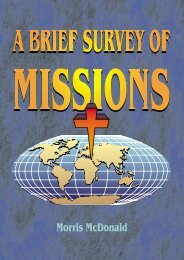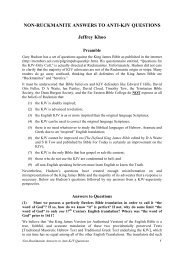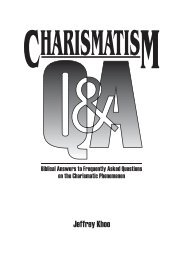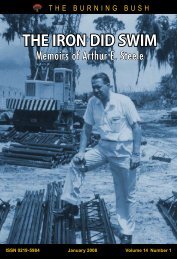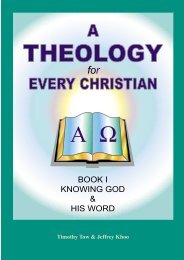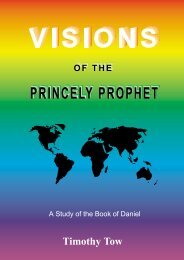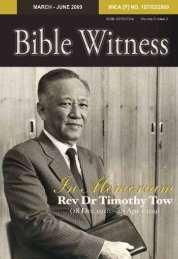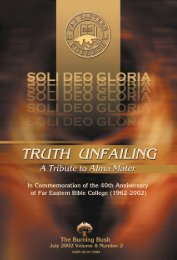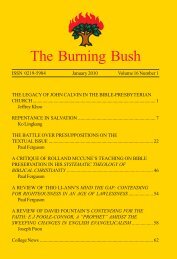50 Years Building His Kingdom - Far Eastern Bible College
50 Years Building His Kingdom - Far Eastern Bible College
50 Years Building His Kingdom - Far Eastern Bible College
You also want an ePaper? Increase the reach of your titles
YUMPU automatically turns print PDFs into web optimized ePapers that Google loves.
Life<br />
<strong>Bible</strong>-Presbyterian<br />
Church<br />
Page 72<br />
this, believe that the writer was using “the language of appearance,” that is, the<br />
Flood appeared to be universal because it covered everything within man’s immediate<br />
scope of observation. The following confirms that the Flood was universal<br />
and not local:<br />
i. The Depth of the Flood (Gen 7:19-20).<br />
If the Flood were only restricted in area, it is difficult to comprehend the<br />
fact that it covered the highest mountains, even in a small area, without<br />
overflowing to other areas. The fact that water seeks its own level seems<br />
to be decisively against a local flood.<br />
ii. The Duration of the Flood<br />
It appears that the Flood lasted for over one year in all from the time<br />
Noah entered the ark until he left it; most of that time the water was upon<br />
the earth. No local Flood in history ever lasted that long. Any flood which<br />
endured for such a long period would, therefore, have to be universal.<br />
iii. The Size of the Ark<br />
Why would Noah build a vessel large enough to accommodate all the<br />
land species on earth when all he needed was one large enough to save<br />
the species indigenous to Mesopotamia, of which there must have been<br />
very few<br />
iv. The Need For an Ark at All<br />
More fatal to the local Flood theory is the utter lack of any need for an ark<br />
in such an event, for Noah could easily have walked from the scene of the<br />
impending disaster, taking with him any animals which were in any danger<br />
of drowning. Why spend 120 years building a boat for which there<br />
was no real need<br />
v. The Testimony of Peter<br />
In 2 Peter 3:3-7, Peter argues that at the end of this age God will destroy<br />
the world with fiery judgment. He bases his arguments for the extensiveness<br />
of this judgment on the analogy of the destruction by water in Noah’s<br />
time. If Peter is trying to teach a universal devastation by fire, which he<br />
assuredly is, why would he compare it to merely a local Flood in Noah’s<br />
time<br />
vi. The Testimony of Rock Strata<br />
The great thicknesses of sedimentary rock strata found throughout the<br />
world, and the existence of huge canyons (eg. the Grand Canyon) can be<br />
best explained as the results of a Universal Flood.<br />
15. “We do believe Isaiah 7:14 is a strictly messianic prophecy historically fulfilled only<br />
by Jesus Christ who was conceived supernaturally in the womb of the virgin Mary by<br />
the power of the Holy Spirit as announced by the angel (Matt 1:22-23, Luke 1:26-<br />
35).”<br />
a. Liberal scholars deny that this was the case, claiming that the Hebrew Word for<br />
“virgin” (ha‘almah) should be translated “young woman” (cf. RSV) and claiming<br />
that the word bethulah would have been used if “virgin” was meant (cf. Gen<br />
24:16). Hence, Isaiah had no intention of predicting the Messiah’s supernatural<br />
virgin birth, and Matthew misquoted this verse in Matthew 1:22, 23. Another<br />
view that removes the supernatural element is found in the Ryrie Study <strong>Bible</strong><br />
which claims that the virgin was a woman that Isaiah was going to marry (Isa 8:3)<br />
and who would bear his child, but who was still a virgin at the time the prophecy<br />
was made.



